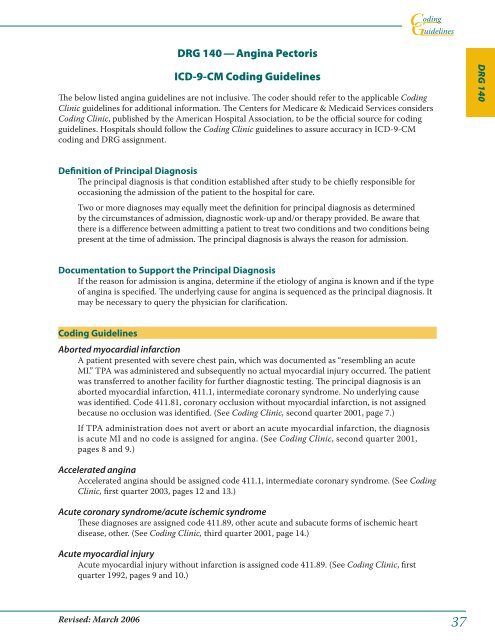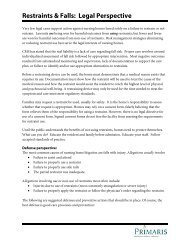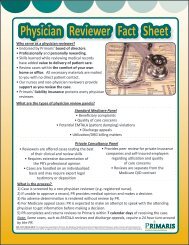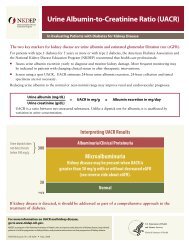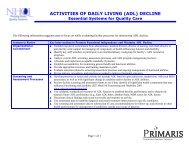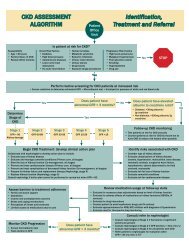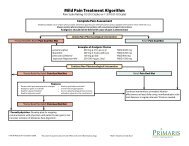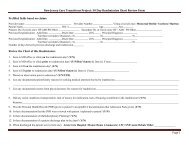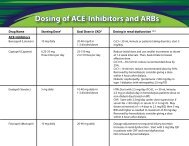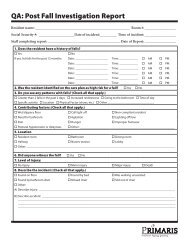DRG 140 â Angina Pectoris ICD-9-CM Coding Guidelines - Primaris
DRG 140 â Angina Pectoris ICD-9-CM Coding Guidelines - Primaris
DRG 140 â Angina Pectoris ICD-9-CM Coding Guidelines - Primaris
Create successful ePaper yourself
Turn your PDF publications into a flip-book with our unique Google optimized e-Paper software.
oding<br />
uidelines<br />
<strong>DRG</strong> <strong>140</strong> — <strong>Angina</strong> <strong>Pectoris</strong><br />
<strong>ICD</strong>-9-<strong>CM</strong> <strong>Coding</strong> <strong>Guidelines</strong><br />
The below listed angina guidelines are not inclusive. The coder should refer to the applicable <strong>Coding</strong><br />
Clinic guidelines for additional information. The Centers for Medicare & Medicaid Services considers<br />
<strong>Coding</strong> Clinic, published by the American Hospital Association, to be the official source for coding<br />
guidelines. Hospitals should follow the <strong>Coding</strong> Clinic guidelines to assure accuracy in <strong>ICD</strong>-9-<strong>CM</strong><br />
coding and <strong>DRG</strong> assignment.<br />
<strong>DRG</strong> <strong>140</strong><br />
Definition of Principal Diagnosis<br />
The principal diagnosis is that condition established after study to be chiefly responsible for<br />
occasioning the admission of the patient to the hospital for care.<br />
Two or more diagnoses may equally meet the definition for principal diagnosis as determined<br />
by the circumstances of admission, diagnostic work-up and/or therapy provided. Be aware that<br />
there is a difference between admitting a patient to treat two conditions and two conditions being<br />
present at the time of admission. The principal diagnosis is always the reason for admission.<br />
Documentation to Support the Principal Diagnosis<br />
If the reason for admission is angina, determine if the etiology of angina is known and if the type<br />
of angina is specified. The underlying cause for angina is sequenced as the principal diagnosis. It<br />
may be necessary to query the physician for clarification.<br />
<strong>Coding</strong> <strong>Guidelines</strong><br />
Aborted myocardial infarction<br />
A patient presented with severe chest pain, which was documented as “resembling an acute<br />
MI.” TPA was administered and subsequently no actual myocardial injury occurred. The patient<br />
was transferred to another facility for further diagnostic testing. The principal diagnosis is an<br />
aborted myocardial infarction, 411.1, intermediate coronary syndrome. No underlying cause<br />
was identified. Code 411.81, coronary occlusion without myocardial infarction, is not assigned<br />
because no occlusion was identified. (See <strong>Coding</strong> Clinic, second quarter 2001, page 7.)<br />
If TPA administration does not avert or abort an acute myocardial infarction, the diagnosis<br />
is acute MI and no code is assigned for angina. (See <strong>Coding</strong> Clinic, second quarter 2001,<br />
pages 8 and 9.)<br />
Accelerated angina<br />
Accelerated angina should be assigned code 411.1, intermediate coronary syndrome. (See <strong>Coding</strong><br />
Clinic, first quarter 2003, pages 12 and 13.)<br />
Acute coronary syndrome/acute ischemic syndrome<br />
These diagnoses are assigned code 411.89, other acute and subacute forms of ischemic heart<br />
disease, other. (See <strong>Coding</strong> Clinic, third quarter 2001, page 14.)<br />
Acute myocardial injury<br />
Acute myocardial injury without infarction is assigned code 411.89. (See <strong>Coding</strong> Clinic, first<br />
quarter 1992, pages 9 and 10.)<br />
Revised: March 2006<br />
37
<strong>DRG</strong> <strong>140</strong><br />
<strong>Angina</strong>/coronary artery disease (CAD)<br />
A patient was admitted with unstable angina, which was secondary to CAD of the native vessels.<br />
CAD was due in part to secondhand tobacco smoke exposure. The principal diagnosis is CAD<br />
of native vessel, 414.01, with secondary diagnoses of unstable angina, 411.1, and secondhand<br />
tobacco smoke, E869.4. (See <strong>Coding</strong> Clinic, second quarter 1996, page 10.)<br />
Code 414.0 had fifth digits added effective 10-1-94. (See <strong>Coding</strong> Clinic, second quarter 1995,<br />
pages 17-19.)<br />
<strong>Coding</strong> and sequencing guidelines for angina and CAD in <strong>Coding</strong> Clinic, volume 10, number 5<br />
1993, pages 17-24, supersedes advice published in <strong>Coding</strong> Clinic, third quarter 1990, pages 6-10.<br />
<strong>Angina</strong> is a symptom. Therefore, when the cause is known the cause is sequenced as the principal<br />
diagnosis. If the cause of angina is unknown, then angina is sequenced as the principal diagnosis.<br />
(See <strong>Coding</strong> Clinic, third quarter 2001, page 15; <strong>Coding</strong> Clinic, second quarter 1997, page 13;<br />
<strong>Coding</strong> Clinic, second quarter 1995, pages 18-19; <strong>Coding</strong> Clinic, second quarter 1994, page 15;<br />
<strong>Coding</strong> Clinic, volume 10, number 5 1993, pages 19 and 20; and <strong>Coding</strong> Clinic, fourth quarter<br />
1993, pages 43 and 44.)<br />
Codes 411.1/411.81<br />
Code 411.1, intermediate coronary syndrome, is not assigned with code 411.81, coronary<br />
occlusion without myocardial infarction (MI). (See <strong>Coding</strong> Clinic, first quarter 1991, page 14.)<br />
No code from category 411, except code 411.0, postmyocardial infarction syndrome, should be<br />
assigned when the infarction has occurred. Postmyocardial infarction syndrome does sometimes<br />
occur on the same admission in which the infarction is treated. (See <strong>Coding</strong> Clinic, second quarter<br />
1995, page 19, and <strong>Coding</strong> Clinic, third quarter 1991, page 24.)<br />
Coronary atherosclerosis of transplanted heart<br />
Code 414.06, coronary atherosclerosis of coronary artery of transplanted heart, is a new code<br />
created effective October 1, 2002. (See <strong>Coding</strong> Clinic, fourth quarter 2002, pages 53 and 54.)<br />
Postinfarction angina<br />
A code for postinfarction angina and a code for AMI may be assigned during the same episode<br />
of care. Postinfarction angina is coded to the type of angina documented by the physician. (See<br />
<strong>Coding</strong> Clinic, second quarter 1995, page 19, and <strong>Coding</strong> Clinic, fourth quarter 1994, page 55.)<br />
Unstable angina/AMI<br />
If a patient is admitted with unstable angina and it is determined after study the patient had AMI,<br />
only AMI is coded. Unstable angina is considered integral to AMI. (See <strong>Coding</strong> Clinic, fourth quarter<br />
1993, pages 39 and 40, and <strong>Coding</strong> Clinic, second quarter 1990, page 15, ODX #3.)<br />
Unstable angina/history of MI<br />
If a patient is admitted for unstable angina, has a history of MI three years ago and angina is<br />
treated during the admission, unstable angina, 411.1, is sequenced as the principal diagnosis and<br />
history of MI, 412, is sequenced as a secondary diagnosis. If MI occurred within eight weeks of<br />
the admission, a code from the 410.x2 series should be assigned. (See <strong>Coding</strong> Clinic, volume 10,<br />
number 5, 1993, pages 18, 19, 20 and 23.)<br />
38<br />
Revised: March 2006


